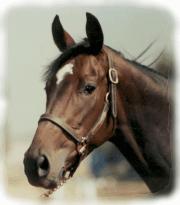A Horse, of Course with Don Blazer |
If you enjoy learning about horses, then you'll love our online courses. Each month you'll find a new column on our web site. We hope you'll enjoy it, and maybe e-mail us with questions or suggestions for other columns. A Horse, Of Course is a monthly column syndicated by Success Is Easy. If you like the column, call your local newspaper, or local horse publication and ask them to subscribe by contacting Success Is Easy. |
The Half Halt Is On Steroids The half halt is on steroids. And a lot more home runs are being hit---in the form of more nice horses working extraordinarily well. And the “beefed-up” half halts get great results for any training discipline. I’ve always employed the half halt. For a horse trainer, it’s a staple. You’ve got to use the half halt if you want horses that respond lightly and consistently, that round up and slow down, and that are prepared for advanced maneuvers such as the flying change of leads. But I was taught, and I did teach, that the rider asked for a half halt, and then released the cue instantly upon any response by the horse. Any attempt to comply by the horse was thought to be good enough. The horse was trying so the horse would be rewarded; progress would be made. I’m learning (from some very accomplished horse trainers) a new way of using something old. The half halt is just what it sounds as if it should be…a halt that isn’t complete. You ask for a half halt by shortening the reins and establishing a bit barrier that would indicate to the horse a stop might be expected. You do not, however, continue the stopping cues. Instead you apply leg pressure to push the horse into the new shortened frame. You want the horse to continue forward movement at the existing gait. In order for the horse to fit into the shorter frame, the horse must round up his back and compress his stride so that the foot flight is more elevated. The horse’s response should be to slow the cadence of his footfall. Done correctly the horse should be in a state of perfect collection and the cadence should be slower and softer. Previously, I’d have removed the bit barrier the instant the horse made any attempt to comply with my half halt request. (With a lot of practice and time, the horse will eventually learn to collect and slow his cadence.) Now I don’t remove the bit barrier, but instead I drive continuously with leg pressure until the horse takes the “perfect” position for the movement that I want. This driving action can last quite some time, and can take quite a bit of effort. Don’t discontinue the driving action just because the horse is trying—the horse has to take the “perfect” position. Once the horse is in the desired frame, moving at the desired speed, with his body in the desired position, the barrier is released. For the western rider that means the reins are pitched and draped. For the English rider it means the hand is relaxed and the horse is on the bit, but without rein restraint. Now the rider must attempt to ride the horse for as long as possible without the reestablishment of any barrier which dictates body position, speed or collection. Of course the horse is going to return to the longer frame with less collection because it is less work; horses can’t justify working harder if it is not necessary. (Unfortunately horses can’t project the reasoning that if they carry weight in “collection” they’ll remain sounder longer. They don’t grasp the idea that being in better condition now, means they’ll be in better condition later. Of course, lots of rider can’t project that reasoning either.) When the horse elongates, increases speed or loses collection, the half halt is again employed. With the half halt on steroids, you do not make any small corrections to help the horse. If you are going to correct, you use the very strong half halt, put the horse back in the perfect position, then remove the barrier completely. There is no “half way” in the steroid half halt. It is helping the horse to take the perfect position, and then it is leaving the horse on his own to continue in that position. If you practice the beefed-up half halt, don’t get frustrated, don’t make tiny adjustments, and don’t abandon the method until you’ve tried it for at least 10 training sessions. Try it; you might like it! Visit A Horse, Of Course on the Internet at www.donblazer.com |
